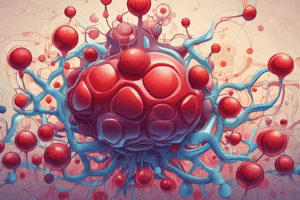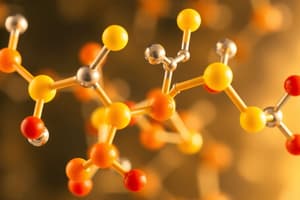Podcast
Questions and Answers
If a biochemist is studying the reaction rates of a metabolic pathway, which aspect of biochemistry is being investigated?
If a biochemist is studying the reaction rates of a metabolic pathway, which aspect of biochemistry is being investigated?
- The informational content encoded within DNA sequences.
- The structural composition of cellular organelles.
- The mechanical properties of structural proteins.
- The dynamic interactions and transformations of biomolecules. (correct)
Which characteristic distinguishes biochemistry from general chemistry?
Which characteristic distinguishes biochemistry from general chemistry?
- Biochemistry is concerned with the synthesis of inorganic compounds.
- Biochemistry focuses solely on reactions in a laboratory setting.
- Biochemistry studies the structures, functions, and interactions of biological macromolecules. (correct)
- Biochemistry uses only computational methods; general chemistry uses only experimental.
Which of the following best describes the central dogma of molecular biology, and thus the flow of information?
Which of the following best describes the central dogma of molecular biology, and thus the flow of information?
- Protein -> RNA -> DNA
- RNA -> Protein -> DNA
- DNA -> Protein -> RNA
- DNA -> RNA -> Protein (correct)
Predict what would happen if a critical enzyme involved in DNA replication had its activity significantly reduced due to a mutation?
Predict what would happen if a critical enzyme involved in DNA replication had its activity significantly reduced due to a mutation?
If a researcher is investigating the effects of a novel drug on a specific metabolic pathway within liver cells, which unit of biological organization is the primary focus of this study?
If a researcher is investigating the effects of a novel drug on a specific metabolic pathway within liver cells, which unit of biological organization is the primary focus of this study?
Which functional group is present in the following compound? (Image of a compound containing an ester group is assumed but not provided)
Which functional group is present in the following compound? (Image of a compound containing an ester group is assumed but not provided)
Inosine contains which of the following functional groups?
Inosine contains which of the following functional groups?
Identify the functional group present in the following compound. (Assume the compound contains a ketone)
Identify the functional group present in the following compound. (Assume the compound contains a ketone)
Which of Koshland's 'Pillars of Life' refers to an organism's capacity to alter its program in response to environmental changes?
Which of Koshland's 'Pillars of Life' refers to an organism's capacity to alter its program in response to environmental changes?
Maintaining a physical state far from equilibrium is a characteristic of living systems described as:
Maintaining a physical state far from equilibrium is a characteristic of living systems described as:
Which 'pillar of life' ensures that metabolic pathways in a cell operate independently, preventing interference?
Which 'pillar of life' ensures that metabolic pathways in a cell operate independently, preventing interference?
Digestive enzyme ribonuclease in bovine and humans are examples of:
Digestive enzyme ribonuclease in bovine and humans are examples of:
Considering the breadth of study, which field focuses on the location, expression, and function of individual genes or small gene groups?
Considering the breadth of study, which field focuses on the location, expression, and function of individual genes or small gene groups?
Which of the following 'omics' approaches focuses primarily on the complete set of proteins and their functions within a cell or organism?
Which of the following 'omics' approaches focuses primarily on the complete set of proteins and their functions within a cell or organism?
A researcher is investigating how different proteins within a cell interact with each other. Which 'omics' field is MOST relevant to this research?
A researcher is investigating how different proteins within a cell interact with each other. Which 'omics' field is MOST relevant to this research?
A scientist aims to analyze the complete set of mRNA transcripts in a cell to understand gene expression patterns. Which approach should they use?
A scientist aims to analyze the complete set of mRNA transcripts in a cell to understand gene expression patterns. Which approach should they use?
An experiment is designed that measures the rates of metabolic reactions within a cell. This study falls under which of the following categories?
An experiment is designed that measures the rates of metabolic reactions within a cell. This study falls under which of the following categories?
Which cellular component is primarily responsible for regulating the movement of substances into and out of the cell?
Which cellular component is primarily responsible for regulating the movement of substances into and out of the cell?
Which of the following organelles is responsible for breaking down and recycling damaged or unnecessary cellular components?
Which of the following organelles is responsible for breaking down and recycling damaged or unnecessary cellular components?
Which biomolecule primarily functions to control chemical reactions within a cell?
Which biomolecule primarily functions to control chemical reactions within a cell?
What is the primary function of the Golgi apparatus within a cell?
What is the primary function of the Golgi apparatus within a cell?
A researcher is studying the complete set of sugars in a biological sample. Which field of study is this?
A researcher is studying the complete set of sugars in a biological sample. Which field of study is this?
In the context of biomolecules, what is the primary role of DNA and RNA?
In the context of biomolecules, what is the primary role of DNA and RNA?
Which of the following best describes the function of carbohydrates in living organisms?
Which of the following best describes the function of carbohydrates in living organisms?
What key roles do lipids play in biological systems?
What key roles do lipids play in biological systems?
Friedrich Wöhler's synthesis of urea in 1828 challenged which prevailing scientific belief?
Friedrich Wöhler's synthesis of urea in 1828 challenged which prevailing scientific belief?
What was the significance of Stanley Miller's 1953 experiment?
What was the significance of Stanley Miller's 1953 experiment?
Which of the following is a direct implication of the 'RNA World' hypothesis?
Which of the following is a direct implication of the 'RNA World' hypothesis?
If a newly discovered biomolecule is found to be primarily composed of long hydrocarbon chains, which class of biomolecules would it most likely belong to?
If a newly discovered biomolecule is found to be primarily composed of long hydrocarbon chains, which class of biomolecules would it most likely belong to?
Flashcards
Biochemistry
Biochemistry
The study of the chemical substances and vital processes occurring in living organisms.
The Cell
The Cell
The fundamental structural and functional unit of all known living organisms.
Molecules
Molecules
Substances made from two or more different elements that are chemically bonded.
Elements
Elements
Signup and view all the flashcards
Organic Chemistry
Organic Chemistry
Signup and view all the flashcards
Genome
Genome
Signup and view all the flashcards
Proteomics
Proteomics
Signup and view all the flashcards
Transcriptomics
Transcriptomics
Signup and view all the flashcards
Metabolomics
Metabolomics
Signup and view all the flashcards
Interactomics
Interactomics
Signup and view all the flashcards
Lipidomics
Lipidomics
Signup and view all the flashcards
Glycomics
Glycomics
Signup and view all the flashcards
Fluxomics
Fluxomics
Signup and view all the flashcards
Major Classes of Biomolecules
Major Classes of Biomolecules
Signup and view all the flashcards
Proteins/Enzymes Role
Proteins/Enzymes Role
Signup and view all the flashcards
DNA/RNA Function
DNA/RNA Function
Signup and view all the flashcards
Carbohydrates Role
Carbohydrates Role
Signup and view all the flashcards
Lipids Function
Lipids Function
Signup and view all the flashcards
Vitalism Theory
Vitalism Theory
Signup and view all the flashcards
Wöhler's Urea Synthesis
Wöhler's Urea Synthesis
Signup and view all the flashcards
Organic Functional Groups
Organic Functional Groups
Signup and view all the flashcards
Ester
Ester
Signup and view all the flashcards
Amine
Amine
Signup and view all the flashcards
Ether
Ether
Signup and view all the flashcards
Carboxylic Acid
Carboxylic Acid
Signup and view all the flashcards
Amide
Amide
Signup and view all the flashcards
Program (Pillar of Life)
Program (Pillar of Life)
Signup and view all the flashcards
Improvisation (Pillar of Life)
Improvisation (Pillar of Life)
Signup and view all the flashcards
Study Notes
- Chapter 1 is an overview and comments on Biochemistry and the language of chemistry
- Chapters 1, 2, and 3 are review chapters that will be combined for quizzes and worksheets
Elements and Molecules of Living Systems
- The human body is composed of 65% Oxygen, 18% Carbon, 9.5% Hydrogen, 3.2% Nitrogen etc.
- Stanley Miller conducted an experiment in 1953 recreating early earth atmospheric conditions
- Miller's experiment used electrodes and gases to create amino acids
Functional Groups
- Biomolecules commonly contain functional groups
- Functional groups include Aldehydes, Amides, Aminos, Carbonyls, Carboxylic acids etc.
- The main classes of biomolecules are proteins/enzymes, DNA/RNA, carbohydrates, and lipids
Macromolecules
- Macromolecules form by polymerization
- Monomer subunits form covalent bonds to make up a polymer
- Proteins consist of amino acids
- Lipids consist of glycerol and fatty acids
- Carbohydrates consist of monosaccharides
- Nucleic acids consist of nucleobases and nucleotides
- Natural biopolymers include cellulose, dextran, starch, pullulan, chitosan, hyaluronic acid, alginate, heparin and xathan gum
- Fatty acyls are composed of methylene groups and fatty acids
- Sterol lipids contain a steroid nucleus
- Glycerolipids contain glycerol molecules and fatty acids
- Prenol lipids contains C5 units
- Saccharolipids have sugars as a backbone
- Glycerophospholipids contain glycerol, fatty acids and phosphate groups
- Sphingolipids contain sphingosine backbones
Vitalism
- In the 19th century, Friedrich Wohler shocked the science world
- Wohler created urea from ammonium cyanate in a lab
- Urea was previously believed to only be synthesizable via biological organisms
Distinguishing Characteristics of Living Systems
- 7 Distinctive "Pillars of Life” are as follows
- Program: Organized plan for constitution and reproduction
- Improvisation: Capacity for change in program to promote survival as the environment changes
- Compartmentalization: Ability of organism to separate itself from environment to control conditions
- Energy: Order through chaos requiring energy and metabolism
- Regeneration: Maintaining physical state far from equilibrium
- Adaptability: Response to environmental change
- Seclusion: Metabolism and other pathways work independently even in the same compartment of the cell
Miscellaneous Definitions
- Homologs have a common ancestor
- Paralogs have the same organisms but different biochemical functions
- Orthologs have different species with similiar function
- Prokaryotes are cells with a nucleoid, Pili, capsule, cell wall, cytoplasm, plasma membrane, and ribosomes
- Eukaryotes possess a smooth ER, mitochondria, centriole, golgi apparatus, nucleolus, and nucleus
Bioinformatics and Omics Study
- Bioinformatics uses information science applied to biology
- Mathematical analysis is applied to DNA sequence data
- Bioinformatics can be used in computer simulation
- Genomic studies totality of genetic information
- Genetic study refers to the individual genes and traits
- Omics studies include Proteomics (proteins), Transcriptomics (mRNA), Metabolomics (metabolites), Interactomics (protein interactions), Lipidomics (lipids), Glycomics (carbohydrates), and Fluxomics (metabolic rates)
- "In-silico" refers to performing work on a computer with virtual simulation
- "In-vitro" means in glass, and can represent study of cells in a test tube
- "In-vivo" means in life, and represents the study of the process of life, of cells in a living organism
- Amphipathic: Having both hydrophilic and hydrophobic parts
Studying That Suits You
Use AI to generate personalized quizzes and flashcards to suit your learning preferences.
Related Documents
Description
Overview of biochemistry, focusing on the chemical elements and molecules in living systems, functional groups, and the formation of macromolecules through polymerization. Key topics include the composition of the human body, the Miller experiment, and the main classes of biomolecules.




